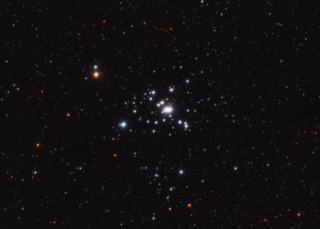
- Constellation: Camelopardalis
- Right Ascension: 04h 07.50m
- Declination: +62° 19.9
- Distance: 2,700 ly
NGC 1502 is an open cluster located in the constellation of Camelopardalis. It is near one end of a string of unrelated stars that seem to flow towards it that is called Kemble's Cascade. The cluster consists of around 45 stars and estimated distance of 2,700 light years away and is estimated to be a young cluster of around 11 million years old. The bright double star Struve 485 located near the center.
- Details
- Category: Open Clusters
- Telescope: Explore Scientific 127 Refractor
- Camera: Atik 314l+

- Constellation: Perseus
- Right Ascension: 2h 20m
- Declination: 57° 08′
- Distance: 7,500
Located in the constellation of Perseus are the two open clusters of NGC 869 and NGC 884. Both are at a distance of around 7,500 light years away. Both are a relative young age of 13 million years. The clusters are separated by a few hundred light years. Each cluster consists 300 to 400 stars with NGC 869 being slightly brighter and more compact.
- Details
- Category: Open Clusters
- Telescope: EDT 80mm Reftactor
- Camera: ZWO A071 Color

- Constellation: Cassiopeia
- Right Ascension: 23h 24.2m
- Declination: +61° 35′
- Distance: 3,000 - 7,000 light years
Messier 52 is an open cluster located in Cassiopeia. It contains around 193 members. Its estimated distance is between between 3,000 and 7,000 light years. The differences in distances are due to a large amount of interstellar dust in that direction that varies the brightness by an unknown amount.
- Details
- Category: Open Clusters
- Telescope: Explore Scientific 127 Refractor
- Camera: Atik 314l+

- Constellation: Taurus
- Right Ascension: 03h 47m 24s
- Declination: +24° 07′ 00″
- Distance: 444 ly
Messier 45 or as it is often called, The Pleiades. The name is possibly derived from ancient Greek word "plein" meaning to sail. It is often called the Seven Sisters as the brightest stars are named for the Greek mythological sisters of Atlas and Pleione, Alcyone, Electra, Maia, Merope, Taygeta, Celaeno, and Asterope or Sterope.
The reflection nebula around the cluster was originally thought to be left over dust from the clusters formation, but due to the age of the cluster, that nebulosity would have been dispersed. It seems it is just passing through an dusty region.
The cluster is an estimated 444 light years away, contains over 1,000 members and a large number of brown dwarf objects. Like most clusters, it will slowly disperse over millions of years. The cluster's age is estimated to be between 75 and 150 million years old.
- Details
- Category: Open Clusters
- Telescope: EDT 80mm Reftactor
- Camera: ZWO A071 Color

- Constellation: Andromeda
- Right Ascension: 01h 57m 41s
- Declination: +37° 47.1′
- Distance: 1,300 ly
NGC 752 is an open cluster of stars located in Andromeda. Consisting of around 60 members is located 1,300 light years away. Many distant galaxies are scattered through out the the image.
- Details
- Category: Open Clusters
- Telescope: EDT 80mm Reftactor
- Camera: ZWO 1600 MM

- Constellation: Cygnus
- Right Ascension: 21h 31m 42s
- Declination: +48° 25′ ″
- Distance: 1,060 ly
Open cluster nestled against the background star field of Cygnus. The cluster is composed of about 30 members and is located approximately 1,060 light years away. Estimated age is 278 million years.
- Details
- Category: Open Clusters
- Telescope: EDT 80mm Reftactor
- Camera: ZWO 1600 MM